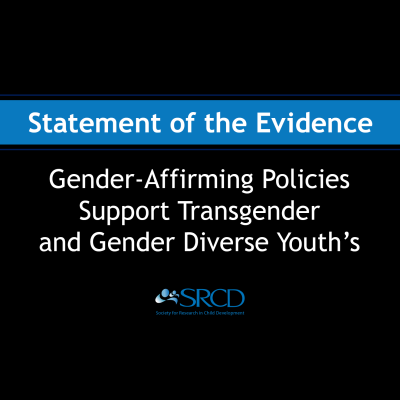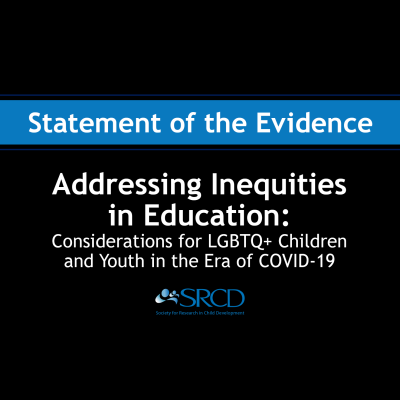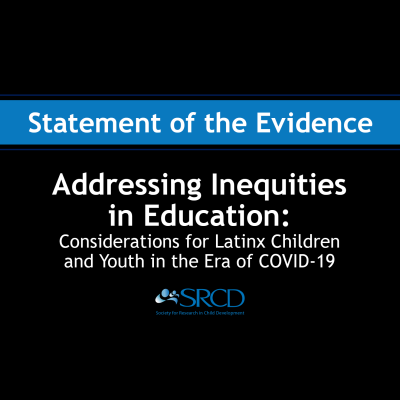Reducing Prejudice and Promoting Equity in Childhood
Social Policy Report Brief, Volume 25, Issue 4
Why Does This Matter?
Millions of children worldwide struggle as a result of prejudice and discrimination due to race, ethnicity, gender, religion, disability, indigenous background, and age. In many countries, intergroup tension is rising amid growing immigrant populations and increasing ethnic diversity. Legal mandates are the first step in laying the foundation against discrimination and prejudice; the next step involves changes in social interactions. To be effective, intervention programs should be informed by developmental science research and used more widely.
For interventions to be effective in promoting equity and tolerance, as well as laying a foundation against prejudice and discrimination, they must begin in childhood when attitudes are starting to form and develop.
Policy and Practice Implications
There is evidence that three types of intervention approaches are effective:
- Peer-to-peer interventions that foster intergroup contact among children in which different groups are given equal status, are supported by institutional authorities like senior school staff, have common goals, and work cooperatively rather than competitively;
- Adult-child interventions that involve adults conveying messages that promote tolerance, mutual respect, and equality, and that involve teacher-facilitated multicultural approaches in the classroom; and
- Intervention approaches that address children’s understanding of social relations, including their concepts of morality, human rights, group identity, and group status, as well as the social and historical context of different groups.
What the Research Says
- Studies show that discrimination and prejudice are part of life for many youths. One study in the United States found that 75% of African American adolescents and 65% of Hispanic adolescents reported being hassled by a store clerk or security guard because of their race or ethnicity. Another study from the United Kingdom reported evidence of differential treatment of ethnic minority students, with Black and Afro-Caribbean boys being four to five times more likely than their White counterparts to be permanently excluded from school for the same offense.
- In many cases, children experience discrimination and prejudice as members of multiple groups, such as low-income minority adolescents.
- Efforts to identify effective practices for children are limited. A review of over 900 articles, reports, and studies found that few programs specifically address children.
- In contrast to common perceptions: 1) Children are aware of what it means to experience discrimination, even before adolescence, 2) changing children’s attitudes is not solely a top-down process in which children are asked to model adult behavior; instead, teaching must include promoting positive peer interactions as well as fostering direct and indirect contact with outgroup members, and 3) discrimination experiences in childhood are related to adult forms of prejudice, and provide the basis for understanding how adult forms of prejudice emerge.
- While limited in number, some approaches to reducing prejudice have been found to change attitudes, including some school-based curricula (cooperative learning, multicultural curricula, and anti-bias training), which have produced modest gains in positive beliefs. Further work is needed to determine which are most effective.
Facts at a Glance
- The United Nations Convention on the Rights of the Child aims to recognize the dignity, rights, and freedoms of children, and to strengthen their protection from discrimination. Even though the Convention has not been ratified by the United States, it provides a framework for interventions and curricula—in the United States and throughout the world—that challenge traditions and attitudes that perpetuate discrimination and prejudice.
- Interventions and curricula have been used in many areas of conflict, including the Balkans, Indonesia, South Africa, Northern Ireland, and the Middle East. One example is Nashe Maalo (Our Neighborhood), a Macedonian children’s television program that represents children of different ethnicities in an effort to promote mutual respect and understanding.
- Interventions and curricula have also been used to address immigration-related discrimination and prejudice. In the Netherlands, for example, schoolbased programs promote tolerance, awareness of discrimination, cultural understanding, and prejudice reduction.
- While prejudice and discrimination are global, detailed documentation of how these biases have a negative effect on children comes from research on ethnic minority status primarily in the United States—most of it focused on African American children, though also recently focusing on children of Asian, Latino, and Middle Eastern backgrounds.
- A number of interventions and curricula have been used in the United States. One of the most recognizable is Sesame Street, which promotes parent-child discussions and conveys messages to children about intergroup attitudes.
This brief summarizes a longer Social Policy Report, "Promoting Equity, Tolerance, and Justice in Childhood," by Melanie Killen, Professor of Human Development and Quantitative Methodology at the University of Maryland, Adam Rutland, Professor of Developmental Psychology at the University of Kent, Canterbury, and Martin D. Ruck, Associate Professor, Ph.D. Programs in Developmental Psychology and Urban Education at the City University New York.


